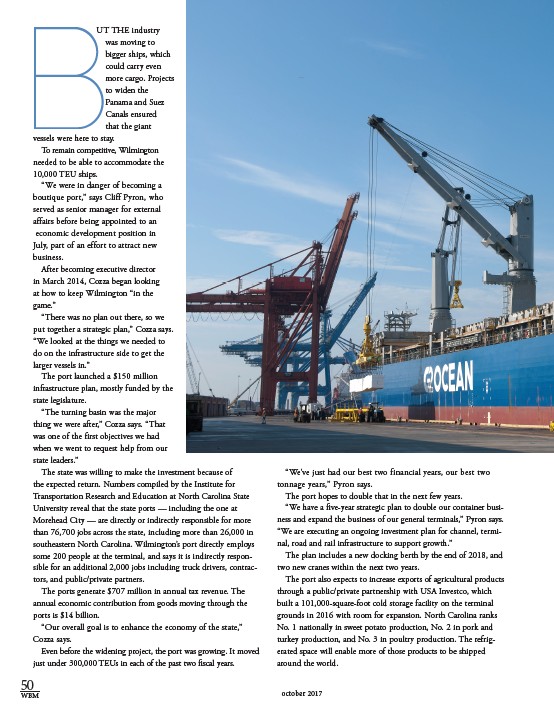
B
UT THE industry
was moving to
bigger ships, which
could carry even
more cargo. Projects
to widen the
Panama and Suez
Canals ensured
that the giant
vessels were here to stay.
To remain competitive, Wilmington
needed to be able to accommodate the
10,000 TEU ships.
“We were in danger of becoming a
boutique port,” says Cliff Pyron, who
served as senior manager for external
affairs before being appointed to an
economic development position in
July, part of an effort to attract new
business.
After becoming executive director
in March 2014, Cozza began looking
at how to keep Wilmington “in the
game.”
“There was no plan out there, so we
put together a strategic plan,” Cozza says.
“We looked at the things we needed to
do on the infrastructure side to get the
larger vessels in.”
The port launched a $150 million
infrastructure plan, mostly funded by the
state legislature.
“The turning basin was the major
thing we were after,” Cozza says. “That
was one of the first objectives we had
when we went to request help from our
state leaders.”
The state was willing to make the investment because of
the expected return. Numbers compiled by the Institute for
Transportation Research and Education at North Carolina State
University reveal that the state ports — including the one at
Morehead City — are directly or indirectly responsible for more
than 76,700 jobs across the state, including more than 26,000 in
southeastern North Carolina. Wilmington’s port directly employs
some 200 people at the terminal, and says it is indirectly respon-sible
for an additional 2,000 jobs including truck drivers, contrac-tors,
and public/private partners.
The ports generate $707 million in annual tax revenue. The
annual economic contribution from goods moving through the
ports is $14 billion.
“Our overall goal is to enhance the economy of the state,”
Cozza says.
Even before the widening project, the port was growing. It moved
just under 300,000 TEUs in each of the past two fiscal years.
“We’ve just had our best two financial years, our best two
tonnage years,” Pyron says.
The port hopes to double that in the next few years.
“We have a five-year strategic plan to double our container busi-ness
and expand the business of our general terminals,” Pyron says.
“We are executing an ongoing investment plan for channel, termi-nal,
road and rail infrastructure to support growth.”
The plan includes a new docking berth by the end of 2018, and
two new cranes within the next two years.
The port also expects to increase exports of agricultural products
through a public/private partnership with USA Investco, which
built a 101,000-square-foot cold storage facility on the terminal
grounds in 2016 with room for expansion. North Carolina ranks
No. 1 nationally in sweet potato production, No. 2 in pork and
turkey production, and No. 3 in poultry production. The refrig-erated
space will enable more of those products to be shipped
around the world.
50
WBM october 2017